| Secrets of Digital Photography / 8 Megapixel Cameras Packed! 5-25-04 |
|
Jump back to Breaking News... |
Canon has been at the crest of the digital wave since day one. Along the way they have produced some of the top examples of digital camera gear from tiny pocket cameras to full-frame dSLR professional gear. Beyond cameras, they make scanners, printers and software. Where digital photography is concerned, Canon may well be the world leader in pixel slinging. This year they've produced a new camera to join the 8-megapixel race. So have Sony, Nikon, Olympus and Minolta. Together, these are the big five in digital imaging. Sony makes
the image chip that has the eight million photosites (some Canon
cameras have Canon imagers) and their 828 was the first camera
out the door that demonstrated what the chip could do. In fact,
Sony was so impressed with their own chip that they made a variation
with half of the green photosites covered with a slightly First off, the Canon PowerShot Pro1 is compact. In fact, it's the smallest 8-meg camera yet, even though it covers the same zoom range of the big-lens Sony. With a 7:1 zoom, the Pro1 sweeps out wide angle 28mm to full tele 200mm views (35mm equivalent) while delivering a comfortable f/2.4 to 3.5 over the whole range. But the camera folds up into a tight package small enough for a jacket pocket.
Construction is sculpted metal and plastic sprinkling 14 buttons, a selector dial, a scroll dial, a two-way momentary switch and a four-way joy button over its surfaces plus a large twist-ring control for the motorized zoom. You hold the camera with two hands like an SLR, looking through the internal live viewing monitor most of the time, I find, but the flip-out swiveling external monitor can be used as well, depending on your shooting style and preferences. The camera is full of features, nearly all of them a button or two away from the immediate view. Displays make intuitive, easy to change selections immediately visible with a minimum of clever decorative touches. Selections are direct and the graphics are neat and sparse. It almost looks like the Menu and Func. graphics were designed in Switzerland, home of Helvetica type and "less is more." But like any digital camera, the ergonomic department has its own theories as to what's the right way to do things. The four controls to the right of the external monitor bay do everything--almost. A scroll
wheel for your right index finger snuggles up to the shutter
release on top and provides a press switch for instigating quick
jumps between Shutter Speed and F-Stop in Manual Exposure Mode.
The menus don't get in the way. The graphics are rather see-through and the Func (shot functions) options do a good job of hugging the left side and bottom of the image without obscuring it. Simply starting to press the shutter release temporarily suspends menu selection and returns you instantly to shooting mode. After a shot is made, the graphics return. You can even bring up the Func selections (ISO, Effects, Bracketing, Flash EV adjust, Compression and Image Size), then switch on the Menu (three pages including additional Camera preferences and two Set Up pages). Dismissing the Menu at that point returns you to the Func settings, as if they had been covered over by the Menu screens, not replaced by them.
What they really mean is 8M, 4M, 3M, 0.8M and VGA. Fortunately, as each letter block is selected, the actual size in pixels is also displayed so there's no chance of your getting confused as there is with the Olympus 8080. 3264 x 2448, 2272 x 1704, 1600 x 1200, 1024 x 768 and 640 x 480 images are instantly available. At the end this selection is RAW, meaning a CCD-direct RAW image capture at full frame size. I would have thought that RAW would be filed under compression settings, but it makes a certain sense here, since RAW always is captured at full frame size.
Normal tends to show artifacts at 100% viewing size, and Superfine tends to look completely free of them as you would expect. Above these rides the possibility of shooting RAW format and letting your computer sort things out. The RAW advantage being at least a full stop better highlight and shadow capture (+2 stops overall), but of course, RAW takes longer to shoot and process with your computer. Flip-out monitoring is a breeze. The screen is transflective, so it works in full sun. Images on it look quite good; even better in shade or indoors with the illuminator doing the work. Framing shots with the Pro1 is facilitated with the large zoom ring surrounding the base of the lens. It's a zoom by wire arrangement, so there is some lag between finger movement and mechanical response, but the degree of precision it permits is quite high. Unlike toggle controls on the Olympus and Nikon 8-meggers, it's very precise, although not as precise--nor as fast--as the direct mechanical zoom control of the Sony 828. Shutter release speed with the Canon PowerShot Pro1 isn't fast. Sony demonstrated with their fast reacting 828 that the time between live viewing and focused exposure could be lower than half of a second, but the Canon seems to always take a second (or more) to settle in to auto-focused shots. This is my biggest complaint about the camera. It makes certain candid situations into candidn'ts. Mr. Canon: Solve this. If you get the camera to react 2/3 as fast as the Sony, you will gain major points. Anybody who wants this camera needs to put their hands on one in a camera store to see if this "feature" means as much to you as it does to me.
You can still see the whole shot coming together, but the enlarged mid section lets you focus critically as if the lens were being manually adjusted. When you let go of the MF button, the enlargement disappears so you can shoot, and the manual focus obtained is immediately dismissed after the shot is made, so the next image can be with auto-focus. But if you want to shoot another image at the same focus point, simply pulse the MF button again, and the camera stays where it was last focused for another shot. And another, etc. Alternatively, you can hold the MF button down and shoot a string of Continuous shots all at the same focus point. As soon as the camera experiences a half-press, the enlargement effect is dismissed. With auto-focus shots, the half-press condition produces a settled image and primes the systems for a fast exposure. Lag between full press and shutter opening is minimal, on the order of 1/10 second or so. Used this way, critical moments can be captured if they can be anticipated. It's not as fast overall as the quick response one feels from the Canon Digital Rebel dSLR, but that's another story. There are loads of other features packed into the Pro1:
Focus Bracket is found under the Bracket option on the Func. page, too. Here the camera shoots a string of three shots pulling a little focus to and fro of your target subject. For ambiguous focus situations it can help rescue an image. You even get to define a rough range of focus to the bracket. 
I had this camera with me for the recent China shoot and it's features quickly revealed it to be capable, friendly, flexible and easy to work with. It never confused me for more than a few seconds and it could have easily been the only camera on a trip of this sort. 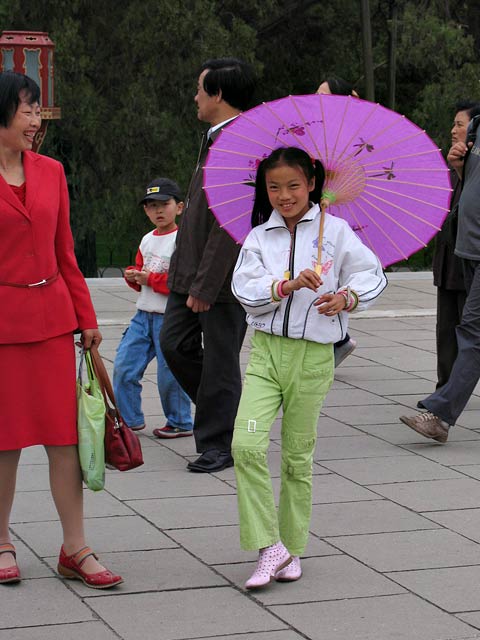 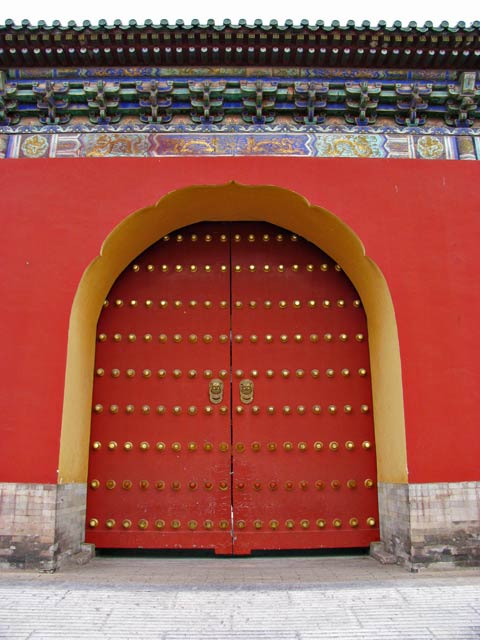 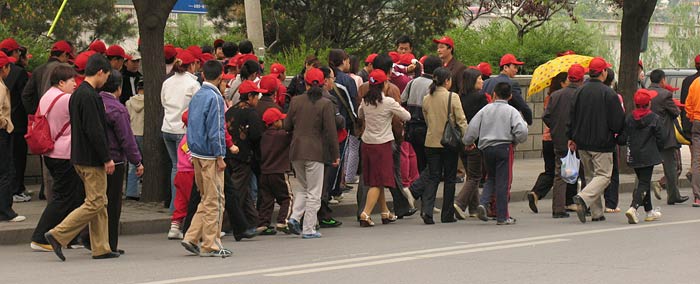
Very good, Mr. Canon; you get a B+. Picture quality is quite good, camera operation is intuitive and feature-rich and it feels good to shoot with. Battery life is long and the camera is a joy to use. The lag between shutter half-press and the camera becoming ready for image gathering is something of a show stopper, but the pictures themselves are very sweet. Later... -iNova Read the news from the digital camera testers: DPReview (Askey):
Click here.
© 2004 Peter iNova. All rights reserved. Do not reprint.
Simply add a link to this page. |
|
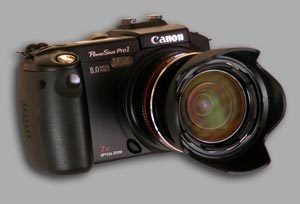 Feature City.
Feature City.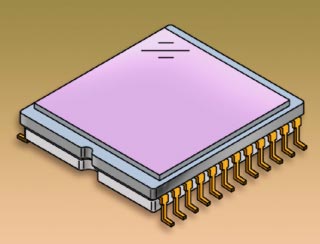 different color they
call emerald--you know, for better color. Now with other 8-meg
cameras to compare to the Sony-exclusive four color chip, the
race is on. We've reviewed the
different color they
call emerald--you know, for better color. Now with other 8-meg
cameras to compare to the Sony-exclusive four color chip, the
race is on. We've reviewed the 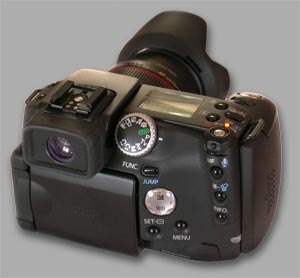 It's not tiny, but for a camera that
delivers the huge 8-meg image, it's quite tidy. and of the whole
group of 8 meg cameras tested so far, it feels the best in my
average size hand.
It's not tiny, but for a camera that
delivers the huge 8-meg image, it's quite tidy. and of the whole
group of 8 meg cameras tested so far, it feels the best in my
average size hand.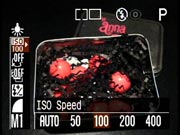 With the Func. selection
items it scrolls among options and the inward momentary switch
action confirms your choice while dismissing the graphics, returning
you to full shooting mode.
With the Func. selection
items it scrolls among options and the inward momentary switch
action confirms your choice while dismissing the graphics, returning
you to full shooting mode.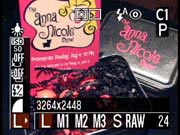 Five frame sizes are available and instantly
selectable. Canon calls them L, M1, M2, M3 and S. Here we go
again.
Five frame sizes are available and instantly
selectable. Canon calls them L, M1, M2, M3 and S. Here we go
again.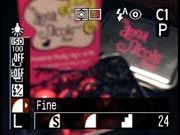 Immediately above frame
size is Compression. Superfine, Fine and Normal are the choices.
Superfine and Fine are hard to tell apart when viewed on your
computer, but Fine delivers 67% more images compared to Superfine,
and Normal delivers over twice as many as Fine and nearly 350%
of the number of Superfine shots.
Immediately above frame
size is Compression. Superfine, Fine and Normal are the choices.
Superfine and Fine are hard to tell apart when viewed on your
computer, but Fine delivers 67% more images compared to Superfine,
and Normal delivers over twice as many as Fine and nearly 350%
of the number of Superfine shots.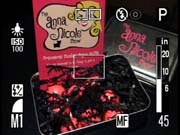 Manual focus, however, has been optimized
in several ways. First, it lets fast-stab exposures happen very
quickly. Second, due to the way the manual focus option works,
it's easy to implement and focus. Your thumb engages the MF button,
and while that is pressed, the zoom ring becomes a manual focus
ring with a critical focus enlarger superimposed over the center
of the shot. It's like a square magnifying effect floating in
the middle of the frame. Notice also that you get a focus distance
barometer marked in small divisions (inches shown).
Manual focus, however, has been optimized
in several ways. First, it lets fast-stab exposures happen very
quickly. Second, due to the way the manual focus option works,
it's easy to implement and focus. Your thumb engages the MF button,
and while that is pressed, the zoom ring becomes a manual focus
ring with a critical focus enlarger superimposed over the center
of the shot. It's like a square magnifying effect floating in
the middle of the frame. Notice also that you get a focus distance
barometer marked in small divisions (inches shown).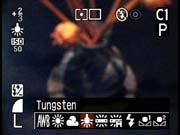 Fast White Balance and EV+/- settings
are made without requiring you to press and hold one button while
scrolling to a selection. Just press to select the feature, then
scroll and select with another digit. This design philosophy
is carried to other buttons that often work by scrolling through
a loop of possibilities (single shot, continuous shots, self-timer
and back to single shot, for instance) without requiring you
to dig into a menu or combine the topic button with a selection
process. This is the right way to do it.
Fast White Balance and EV+/- settings
are made without requiring you to press and hold one button while
scrolling to a selection. Just press to select the feature, then
scroll and select with another digit. This design philosophy
is carried to other buttons that often work by scrolling through
a loop of possibilities (single shot, continuous shots, self-timer
and back to single shot, for instance) without requiring you
to dig into a menu or combine the topic button with a selection
process. This is the right way to do it.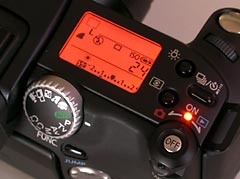 keep
being captured until the cows come home, or your memory card
runs out, whichever comes first. I may have cheated in this test.
I used a SanDisk 1gig Extreme card in the test. Your card may
vary.
keep
being captured until the cows come home, or your memory card
runs out, whichever comes first. I may have cheated in this test.
I used a SanDisk 1gig Extreme card in the test. Your card may
vary.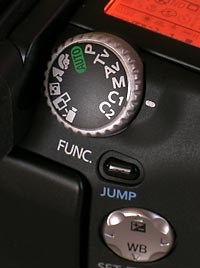 Modes include several Scene modes,
but the big news is that the exposure functions not only include
Auto (simple cam), Program, Time Value (shutter priority), Aperture
Value and Manual (you set it all with the scroll wheel) but two
added modes are instantly selectable; C1 and C2. These are custom
modes that remember all sorts of things; all the preferences
on the camera settings page, the current P, Tv, Av or M exposure
mode, current zoom position, current manual focus distance, all
the current Func. settings and so on. Other digital cameras have
User Modes similar in concept but where Canon has pulled off
a bold Good Thing is by putting them right up front where they
can be accessed directly.
Modes include several Scene modes,
but the big news is that the exposure functions not only include
Auto (simple cam), Program, Time Value (shutter priority), Aperture
Value and Manual (you set it all with the scroll wheel) but two
added modes are instantly selectable; C1 and C2. These are custom
modes that remember all sorts of things; all the preferences
on the camera settings page, the current P, Tv, Av or M exposure
mode, current zoom position, current manual focus distance, all
the current Func. settings and so on. Other digital cameras have
User Modes similar in concept but where Canon has pulled off
a bold Good Thing is by putting them right up front where they
can be accessed directly.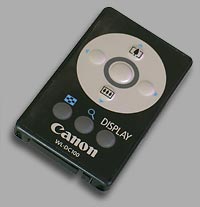 A wireless remote can
be set for these self-timer settings or for instant triggering.
And yes, the remote is included with the camera. Yay!
A wireless remote can
be set for these self-timer settings or for instant triggering.
And yes, the remote is included with the camera. Yay!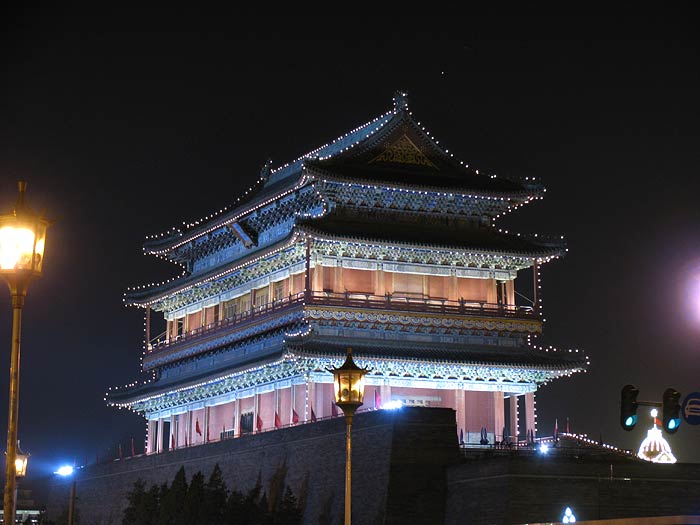
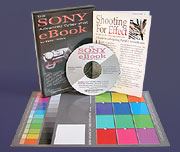
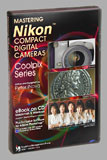 Get
the eBooks
Get
the eBooks